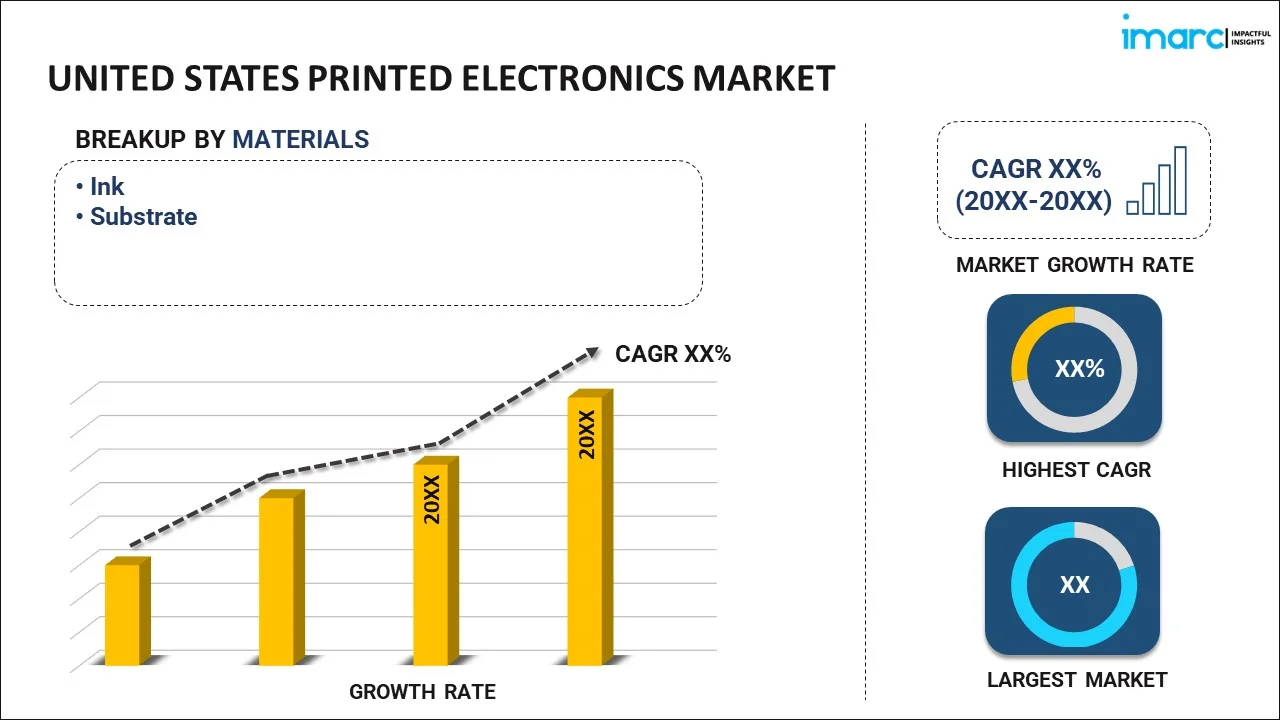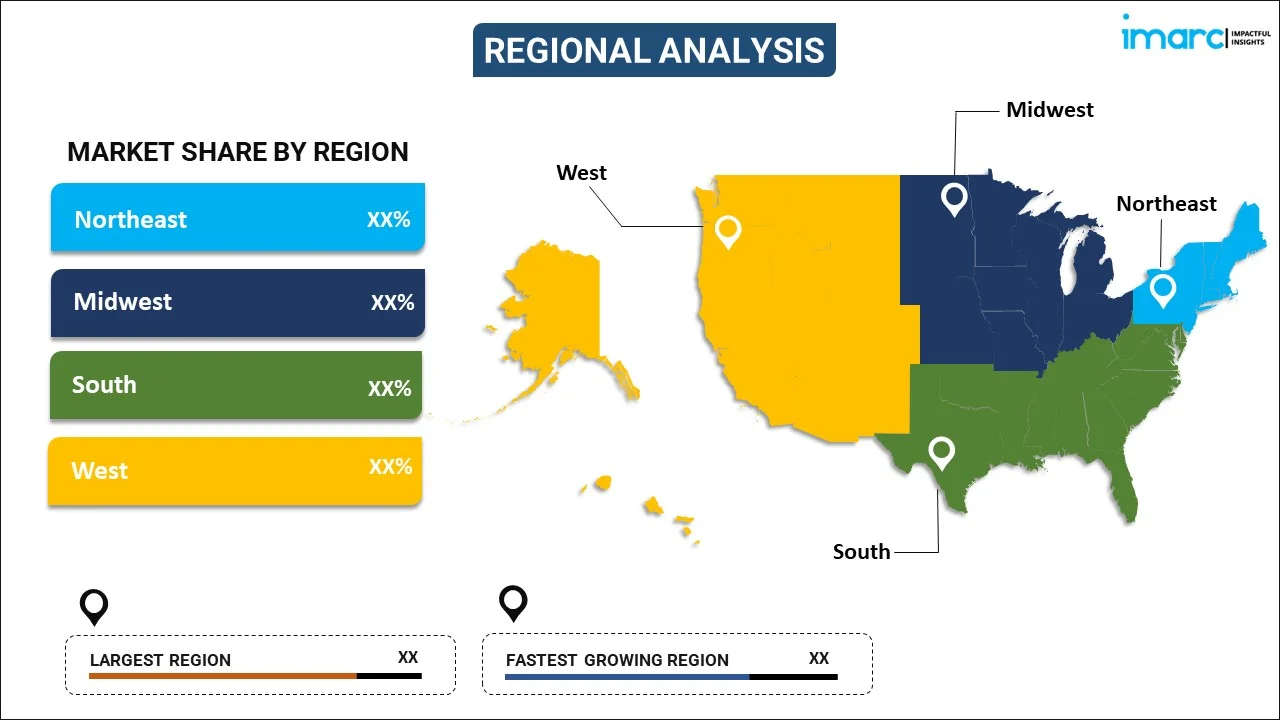
United States Printed Electronics Market Report by Material (Ink, Substrate), Technology (Inkjet, Screen, Gravure, Flexographic), Device (Display, Photovoltaic, Lighting, RFID, and Others), and Region 2024-2032
Market Overview:
The United States printed electronics market size is projected to exhibit a growth rate (CAGR) of 16.60% during 2024-2032. The increased demand for flexible electronics, the growing adoption of printed electronics in various industries, the flexibility and lightweight nature of the product, the rise of IoT and smart devices, and the rapid advancements in printing technologies are some of the factors propelling the market.
|
Report Attribute
|
Key Statistics
|
|---|---|
|
Base Year
|
2023 |
|
Forecast Years
|
2024-2032 |
|
Historical Years
|
2018-2023
|
| Market Growth Rate (2024-2032) | 16.60% |
Printed electronics refers to a set of manufacturing technologies that enable the fabrication of electronic devices using printing processes. Unlike traditional electronics, which typically involve subtractive processes like etching or additive processes like photolithography, printed electronics utilize additive methods to deposit electronic materials onto flexible substrates such as paper, plastic, or even fabric. This innovative approach allows for the creation of flexible, lightweight, and cost-effective electronic components. The key components in printed electronics include conductive inks, substrates, and printing technologies such as inkjet printing or screen printing. Conductive inks containing materials like conductive polymers or nanoparticles are deposited onto a substrate in a precise pattern to form electronic circuits, sensors, or other functional elements. This printing process is highly scalable, enabling large-scale production of electronic devices. Printed electronics find applications across various industries, including consumer electronics, healthcare, automotive, and packaging. Examples of printed electronic devices include flexible displays, RFID tags, sensors, smart labels, and wearable electronics. The ability to print electronic components on flexible substrates allows for the development of bendable and stretchable devices, expanding the possibilities for novel form factors and applications. The advantages of printed electronics include cost efficiency, scalability, and the ability to create lightweight, conformable, and environmentally friendly electronic solutions.
United States Printed Electronics Market Trends:
The market in the United States is majorly driven by the nation's emphasis on technological innovation. In line with this, the increasing investments from government agencies, private enterprises, and academic institutions contribute to the continuous innovation in printing technologies, conductive materials, and applications. This commitment to innovation fosters market growth. Furthermore, the rising demand for lightweight, flexible, and cost-effective electronic devices is driving the adoption of printed electronics. Besides, the growth of the Internet of Things (IoT) and wearable technologies is a significant driver for printed electronics in the U.S. The integration of printed sensors and circuits in IoT devices and wearables contributes to the expansion of the market. Moreover, these electronics offer a more sustainable alternative to traditional manufacturing processes. The use of organic and flexible materials, coupled with additive manufacturing methods, aligns with the growing focus on sustainability. As companies and consumers prioritize eco-friendly practices, the adoption of printed electronics is driven by its potential to reduce environmental impact, creating a positive outlook for the market. The automotive and aerospace industries in the U.S. are increasingly incorporating printed electronics for applications such as flexible displays, lighting, and sensors. The lightweight and customizable nature of printed electronics aligns with the requirements of these industries for efficient and advanced electronic solutions, catalyzing the market. Additionally, the supportive government policies and initiatives further contribute to the growth of the printed electronics market. Funding programs, grants, and regulatory frameworks that encourage research, development, and adoption of printed electronics technologies create a conducive environment for market expansion.
United States Printed Electronics Market Segmentation:
IMARC Group provides an analysis of the key trends in each segment of the market, along with forecasts at the country level for 2024-2032. Our report has categorized the market based on material, technology, and device.
Material Insights:

- Ink
- Substrate
The report has provided a detailed breakup and analysis of the market based on the material. This includes ink and substrate.
Technology Insights:
- Inkjet
- Screen
- Gravure
- Flexographic
A detailed breakup and analysis of the market based on the technology have also been provided in the report. This includes inkjet, screen, gravure, and flexographic.
Device Insights:
- Display
- Photovoltaic
- Lighting
- RFID
- Others
The report has provided a detailed breakup and analysis of the market based on the device. This includes display, photovoltaic, lighting, RFID, and others.
Regional Insights:

- Northeast
- Midwest
- South
- West
The report has also provided a comprehensive analysis of all the major regional markets, which include the Northeast, Midwest, South, and West.
Competitive Landscape:
The market research report has also provided a comprehensive analysis of the competitive landscape in the market. Competitive analysis such as market structure, key player positioning, top winning strategies, competitive dashboard, and company evaluation quadrant has been covered in the report. Also, detailed profiles of all major companies have been provided.
United States Printed Electronics Market Report Coverage:
| Report Features | Details |
|---|---|
| Base Year of the Analysis | 2023 |
| Historical Period | 2018-2023 |
| Forecast Period | 2024-2032 |
| Units | US$ Million |
| Scope of the Report | Exploration of Historical Trends and Market Outlook, Industry Catalysts and Challenges, Segment-Wise Historical and Future Market Assessment:
|
| Materials Covered | Ink, Substrate |
| Technologies Covered | Inkjet, Screen, Gravure, Flexographic |
| Devices Covered | Display, Photovoltaic, Lighting, RFID, Others |
| Regions Covered | Northeast, Midwest, South, West |
| Customization Scope | 10% Free Customization |
| Report Price and Purchase Option | Single User License: US$ 3699 Five User License: US$ 4699 Corporate License: US$ 5699 |
| Post-Sale Analyst Support | 10-12 Weeks |
| Delivery Format | PDF and Excel through Email (We can also provide the editable version of the report in PPT/Word format on special request) |
Key Questions Answered in This Report:
- How has the United States printed electronics market performed so far and how will it perform in the coming years?
- What has been the impact of COVID-19 on the United States printed electronics market?
- What is the breakup of the United States printed electronics market on the basis of material?
- What is the breakup of the United States printed electronics market on the basis of technology?
- What is the breakup of the United States printed electronics market on the basis of device?
- What are the various stages in the value chain of the United States printed electronics market?
- What are the key driving factors and challenges in the United States printed electronics?
- What is the structure of the United States printed electronics market and who are the key players?
- What is the degree of competition in the United States printed electronics market?
Key Benefits for Stakeholders:
- IMARC’s industry report offers a comprehensive quantitative analysis of various market segments, historical and current market trends, market forecasts, and dynamics of the United States printed electronics market from 2018-2032.
- The research report provides the latest information on the market drivers, challenges, and opportunities in the United States printed electronics market.
- Porter's five forces analysis assist stakeholders in assessing the impact of new entrants, competitive rivalry, supplier power, buyer power, and the threat of substitution. It helps stakeholders to analyze the level of competition within the United States printed electronics industry and its attractiveness.
- A competitive landscape allows stakeholders to understand their competitive environment and provides an insight into the current positions of key players in the market.
Need more help?
- Speak to our experienced analysts for insights on the current market scenarios.
- Include additional segments and countries to customize the report as per your requirement.
- Gain an unparalleled competitive advantage in your domain by understanding how to utilize the report and positively impacting your operations and revenue.
- For further assistance, please connect with our analysts.
 Inquire Before Buying
Inquire Before Buying
 Speak to an Analyst
Speak to an Analyst
 Request Brochure
Request Brochure
 Request Customization
Request Customization




.webp)




.webp)












